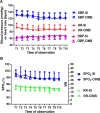The effect of continuous intercostal nerve block vs. single shot on analgesic outcomes and hospital stays in minimally invasive direct coronary artery bypass surgery: a retrospective cohort study
- PMID: 35260084
- PMCID: PMC8903669
- DOI: 10.1186/s12871-022-01607-7
The effect of continuous intercostal nerve block vs. single shot on analgesic outcomes and hospital stays in minimally invasive direct coronary artery bypass surgery: a retrospective cohort study
Abstract
Background: Minimally invasive direct coronary artery bypass (MIDCAB) grafting surgery is accompanied by severe pain. Although continuous intercostal nerve block (CINB) has become one of the multimodal analgesic techniques in single port thoracoscopic surgery, its effects on MIDCAB are unclear. The purpose of this study was to compare the effects of CINB and single shot on analgesic outcomes and hospital stays in patients undergoing MIDCAB in a real-world setting.
Methods: A retrospective cohort study was carried out at Peking University Third Hospital, China. Two hundred and sixteen patients undergoing MIDCAB were divided into two groups: a CINB group and a single block (SI) group. The primary outcome was postoperative maximal visual analog scale (VAS); secondary outcomes included the number of patients with maximal VAS ≤ 3, the demand for and consumed doses of pethidine and tramadol, and the length of intensive care unit (ICU) and hospital stays. The above data and the area under the VAS curve in the 70 h after extubation for the two subgroups (No. of grafts = 1) were also compared.
Results: The maximum VAS was lower in the CINB group, and there were more cases with maximum VAS ≤ 3 in the CINB group: CINB 52 (40%) vs. SI 17 (20%), P = 0.002. The percentage of cases requiring tramadol and pethidine was less in CINB, P = 0.001. Among all patients, drug doses were significantly lower in the CINB group [tramadol: CINB 0 (0-100) mg vs. SI 100 (0-225) mg, P = 0.0001; pethidine: CINB 0 (0-25) mg vs. SI 25 (0-50) mg, P = 0.0004]. Further subgroup analysis showed that the area under the VAS curve in CINB was smaller: 28.05 in CINB vs. 30.41 in SI, P = 0.002. Finally, the length of ICU stay was shorter in CINB than in SI: 20.5 (11.3-26.0) h vs. 22.0 (19.0-45.0) h, P = 0.011.
Conclusions: CINB is associated with decreased demand for rescue analgesics and shorter length of ICU stay when compared to single shot intercostal nerve block. Additional randomized controlled trial (RCT) is needed to support these findings.
Keywords: Block; Coronary artery bypass; Intercostal nerve; Length of stay; Minimally invasive surgery; Outcomes.
© 2022. The Author(s).
Conflict of interest statement
The authors declare that they have no competing interests.
Figures




Similar articles
-
Programmed intermittent bolus for erector spinae plane block versus intercostal nerve block in minimally invasive direct coronary artery bypass surgery: a randomized controlled trial.BMC Anesthesiol. 2025 May 10;25(1):239. doi: 10.1186/s12871-025-03103-0. BMC Anesthesiol. 2025. PMID: 40348972 Free PMC article. Clinical Trial.
-
Pre-operative intercostal nerve blockade for minimally invasive coronary bypass surgery: a standardised anaesthetic regimen for rapid emergence and early extubation.Cardiovasc J S Afr. 2004 Jul-Aug;15(4):178-81. Cardiovasc J S Afr. 2004. PMID: 15322574
-
Evaluation of Serratus Anterior Plane Block for Pain Relief in Patients Undergoing MIDCAB Surgery.Innovations (Phila). 2020 Mar/Apr;15(2):148-154. doi: 10.1177/1556984520908962. Innovations (Phila). 2020. PMID: 32352903 Clinical Trial.
-
Robot-assisted coronary artery bypass surgery: a systematic review and meta-analysis of comparative studies.Can J Surg. 2020 Nov-Dec;63(6):E491-E508. doi: 10.1503/cjs.013318. Can J Surg. 2020. PMID: 33155975 Free PMC article.
-
Does minimally invasive coronary artery bypass improve outcomes compared to off-pump coronary bypass via sternotomy in patients undergoing coronary artery bypass grafting?Interact Cardiovasc Thorac Surg. 2018 Sep 1;27(3):357-364. doi: 10.1093/icvts/ivy071. Interact Cardiovasc Thorac Surg. 2018. PMID: 29579209 Review.
Cited by
-
Anesthesia for Minimally Invasive Coronary Artery Bypass Surgery.J Cardiovasc Dev Dis. 2025 Jun 18;12(6):232. doi: 10.3390/jcdd12060232. J Cardiovasc Dev Dis. 2025. PMID: 40558668 Free PMC article. Review.
-
Optimizing Analgesia After Minimally Invasive Cardiac Surgery: A Randomized Non-Inferiority Trial Comparing Interpectoral Plane Block Plus Serratus Anterior Plane Block to Erector Spinae Plane Block.J Clin Med. 2025 May 28;14(11):3786. doi: 10.3390/jcm14113786. J Clin Med. 2025. PMID: 40507548 Free PMC article.
-
Pain Management in Minimally Invasive Cardiac Surgery: A Review of Current Clinical Evidence.Pain Ther. 2025 Jun;14(3):913-930. doi: 10.1007/s40122-025-00739-1. Epub 2025 Apr 24. Pain Ther. 2025. PMID: 40272720 Free PMC article. Review.
-
Programmed intermittent bolus for erector spinae plane block versus intercostal nerve block in minimally invasive direct coronary artery bypass surgery: a randomized controlled trial.BMC Anesthesiol. 2025 May 10;25(1):239. doi: 10.1186/s12871-025-03103-0. BMC Anesthesiol. 2025. PMID: 40348972 Free PMC article. Clinical Trial.
References
-
- Kettering K, Dapunt O, Baer FM. Minimally invasive direct coronary artery bypass grafting: a systematic review. J Cardiovasc Surg (Torino) 2004;45(3):255–264. - PubMed
-
- Menkis AH, Martin J, Cheng DC, Fitzgerald DC, Freedman JJ, Gao C, Koster A, Mackenzie GS, Murphy GJ, Spiess B, et al. Drug, devices, technologies, and techniques for blood management in minimally invasive and conventional cardiothoracic surgery: a consensus statement from the International Society for Minimally Invasive Cardiothoracic Surgery (ISMICS) 2011. Innovations (Phila) 2012;7(4):229–241. doi: 10.1097/imi.0b013e3182747699. - DOI - PubMed
-
- Rogers CA, Pike K, Angelini GD, Reeves BC, Glauber M, Ferrarini M, Murphy GJ. An open randomized controlled trial of median sternotomy versus anterolateral left thoracotomy on morbidity and health care resource use in patients having off-pump coronary artery bypass surgery: the Sternotomy Versus Thoracotomy (STET) trial. J Thorac Cardiovasc Surg. 2013;146(2):306–16 e1–9. doi: 10.1016/j.jtcvs.2012.04.020. - DOI - PubMed
Publication types
MeSH terms
Substances
LinkOut - more resources
Full Text Sources

